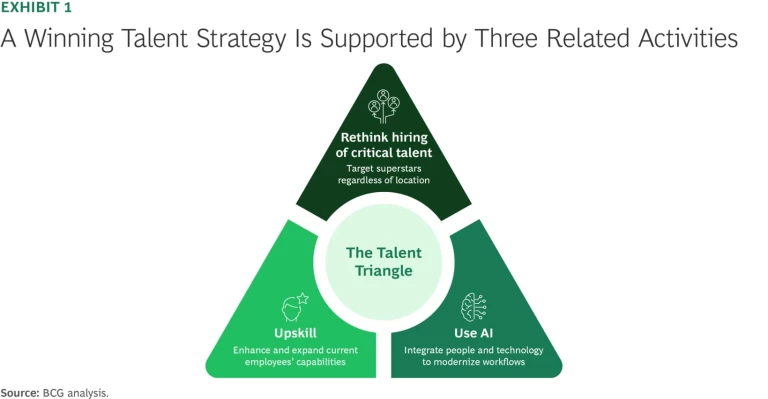Global business has entered an era defined not by a single disruption, but by compounding, volatile forces. The current unpredictability has led analysts to question the reliability of earnings forecasts and some companies to stop issuing earnings guidance. Pullbacks like this have happened only a few times in the past 25 years. Not since the financial crisis of 2008 has there been this degree of change, nor have most CEOs experienced such turbulence since assuming their roles.
In this environment, CEOs must work with CHROs to rethink their operating model and cultivate a flexible workforce that can adjust quickly to multiple possible futures. Central to that evolution is adopting a talent strategy that focuses on a triangle of tightly woven workforce actions: rethinking how to hire talent superstars, adopting AI, and upskilling.
CEOs who successfully build a winning talent strategy today lead with purpose, think in terms of scenarios, deepen their understanding of economic statecraft, and use their CHROs as copilots to help accelerate transformation and execute the company’s goals and priorities.
Stay ahead with BCG insights on people strategy
The Forces Pushing Leaders to Rethink the Meaning of Talent
Powerful forces are reshaping a business landscape that demands strategic foresight and the ability to adapt quickly. They fall into three categories:
- Unbalanced multipolarity, a shift from a few centers of global power to a larger number of nations of unequal influence. The US government’s America First vision, China’s economic transition and pivot, the rise of a confident Global South, and Europe’s “reckoning” to stay competitive are among the developments driving this trend.
- Geopolitical rivalries producing tectonic shifts in world trade, the intensifying race for technological and AI supremacy, and the reemergence of economic nationalism.
- Global shocks that continue to affect business outcomes, including armed conflicts, climate change, and polarized populations.
Volatile conditions and strategic contradictions will not be easily resolved. CEOs, CHROs, and other C-suite leaders have to operate with a sharp awareness of how these forces interact and shape companies’ ability to do business—and prepare their workforce. Leaders must build a talent base that can be adapted and reconfigured in real time—one with flexibility, optionality, and cross-functional skills. By identifying skills and shifts that are valuable across relevant future scenarios, leaders can increase organizational resilience and maximize returns on talent investments.
This type of people strategy cannot be based on traditional workforce. Instead of planning for a linear future, leaders must do scenario planning that accounts for multiple economic, geopolitical, and technological changes, then stress-test their talent strategy against each. Taking this approach will reveal “no-regrets” moves that lead to positive results regardless of the circumstances and the “big rocks”—priorities that companies have to get right.
Leaders must do scenario planning that accounts for multiple economic, geopolitical, and technological changes, then stress-test their talent strategy against each.
To Tackle Future Workforce Needs, Think Triangles
Having the right talent with the right capabilities in the right roles helps companies accelerate and scale changes. This is especially true at a time when the world is embracing more technology, and AI in particular. Organizations that align an AI-influenced people strategy to their business edge and use it to focus on activities that allow them to outperform will pull ahead of the competition. That means hiring top talent with AI-immersed skills, rewiring core workflows to incorporate AI, and retraining employees to work more closely with AI tools.
Winning companies will invest heavily in AI in core processes, and the talent strategy for these domain areas will need to match their technological ambition. CHROs must work in close partnership with CEOs to enable speed, redefine operating models and talent, and drive change.
A deeper dive into the triangle talent strategy shows how the three actions support each other, as well as the advantages and challenges of each. (See Exhibit 1.)

Rethink hiring of critical talent. Companies need to take a global approach to hiring talent superstars—people with highly desirable skills who may only be available in certain areas, whether that means high-end cybersecurity experts clustered in the Baltics or Israel, or laser lithography professionals in the Netherlands. According to new BCG research, only 1.3% of highly skilled professionals relocated across borders in 2024. To reach the vast majority of people with specialized skills in STEM and AI fields who aren’t willing to relocate, companies must determine not only where they are but how to attract, engage, and retain them.
Embracing AI and being quick to respond to changes to the market are two ways to appeal to top talent. So are offering customized career paths and rewarding people for learning cutting-edge skills. Companies must know how to respond if access to talent in specific geographic regions is cut off or if competition makes hiring top talent in certain areas or with certain skills becomes so expensive they need to look elsewhere. And depending on the where top talent is based, companies may also need to deal with shifting immigration regulations.
Competition isn’t the only challenge associated with hiring superstars. Companies expanding into a new business or transforming their operating model may need to change hiring tactics to attract talent with critical skills that the current workforce doesn’t have. They may run into issues integrating such new employees into the culture and HR processes.
Use AI. To be flexible enough to bypass talent constraints or act quickly in the face of rapidly changing business conditions, companies must identify tasks that AI can take over. Adopting an “AI-first” mindset can help companies scale and accelerate change. It also means that work can happen anywhere, which lessens the risks posed by geographic challenges.
Adopting an “AI-first” mindset can help companies scale and accelerate change. It also means that work can happen anywhere, which lessens the risks posed by geographic challenges.
Bringing AI capabilities into the workforce may be the hardest of the three talent triangle components to implement. It requires identifying opportunities to transform work and making the switch to AI a priority for funding and management. It also requires putting people with strong AI skills in charge of building the relevant processes and systems. But if done right, AI transformations create tremendous value by allowing people to focus on more innovative, strategic work. Using autonomous agents for R&D or design, legal reasoning tools, AI copilots for writing code, and other tools fundamentally reshapes core workflows and how work gets done.
Upskill. Talent superstars and AI only go so far. Companies have to future-proof the entire workforce by providing them with opportunities to learn new, AI-based processes and collaborate with AI tools. In addition to helping them gain skills they’ll need in the future, upskilling should focus on work that people are innately better at than machines, such as relationship-based selling or making judgement calls on decisions. For companies, upskilling can reinforce employee loyalty, which allows them to retain institutional knowledge, and should be offered along with other opportunities that would entice people to stay, especially top performers.
Upskilling can be part of a skills-based organization initiative where people constantly learn and deploy new abilities, allowing a company to maximize flexibility and adapt quickly to shifting business demands. However, results may take time and require sustained focus from employees and leaders. For upskilling to be successful, leaders must consider the best way to scale it, which capabilities to start with, and whether the current workforce can take on the challenge or whether it would be more beneficial to turn to external hires who already have the skills.
Leaders can use a combination of two or more of these actions to fill the same types of roles. For example, to evolve manufacturing capabilities, companies may move factories and aggressively upskill workers. Many companies have found that building a future-ready AI engineering workforce requires acting in all three areas—going after superstars, automating tasks, and upskilling current employees.
Putting a Future-Ready Talent Strategy into Action
CEOs and CHROs who successfully navigate turbulent times will build talent strategies that help them act when others still are pondering. They will embrace the opportunities presented by redirecting HR processes to integrate people and AI. (See Exhibit 2.)

For CEOs, this means:
- Use purpose to create stability in the turmoil. In an era of volatility, having a clear, credible purpose provides alignment when conditions fragment, and energy when ambiguity drains confidence. It helps people make hard choices with conviction and stay committed when outcomes are uncertain. CEOs must tap into their organization’s purpose as both a narrative and operating tool: embed it in decision making, communicate it with clarity, and use it to unify differences. In a fragmented world, companies with a clearly defined purpose have the edge.
- Prepare for multiple future outcomes. Top leaders must ditch linear thinking and plan for future situations or events with multiple possible outcomes, and stress-test strategies and talent decisions that could support them. When signals shift, CEOs must be prepared to move fast to make conscious trade-offs between general no-regrets talent moves and big rocks investments.
- Build fluency in economic statecraft. CEOs must upskill themselves and their teams in economic statecraft, learning how policy shapes markets and how to influence that environment. This is essential for making informed decisions in a world where businesses must pivot in response to rapidly evolving dynamics across governmental actors at all levels.
- Make talent your multiplier. CHROs can be change agents to lead organizations to adopt new cultures and mindsets. CEOs can acknowledge that by elevating CHROs to serve as strategic partners. Together, they can position the workforce to accelerate transformation and execute the strategic priorities needed to be more agile and resilient, as well as to ensure their talent strategy is integrated with AI investments. This effort includes reexamining and refreshing the employee value proposition so it’s consistent with the company’s purpose and in line with the dynamics of the local and global talent markets.
For CHROs, it means:
- Be the CEO’s next-generation “talent whisperer.” CHROs must shift from supporting talent in general ways to executing the people side of the CEO’s strategic imperatives with speed and discipline. They must tightly integrate people processes with business priorities and adopt workforce analytics to guide and track performance and course-correct in real time. And they must modernize outdated people processes, beginning with using new approaches to solve big rock talent issues.
- Embrace scenario planning. Like CEOs, CHROs need to embrace scenario planning to identify big rocks and no-regrets talent actions, understanding strategic talent priorities so they can support the company’s agenda in multiple possible eventualities.
- Modernize people systems to sync with strategy. Carrying out the company’s strategies means moving beyond support. CHROs must rewire hiring, learning and development, and performance to executive enterprise priorities.
- Be the chief advocate for change. The talent strategy we’ve described isn’t a one-time transformation. CHROs must build the muscle for ongoing adaptation through clear narratives, steady leadership, and fast course correction.
The next wave of breakout performance won’t come from avoiding volatility. It will come from companies that are more comfortable with volatility, more agile, and more intent on achieving their goals. The current turbulence is as much an opportunity as a threat. In an unpredictable world, talent strategy cannot be an afterthought. It takes foresight to drive competitive advantage. Treat it that way, and you’ll lead.
The authors would like to thank Bill Beaver and Jordan Lockhart for their assistance on this article.






